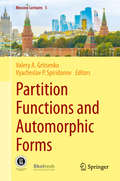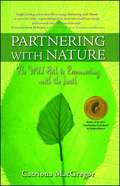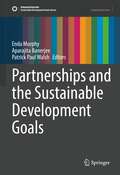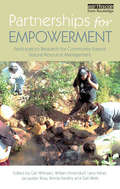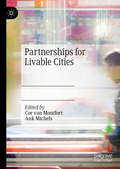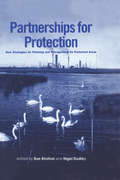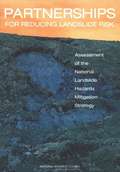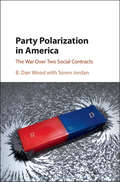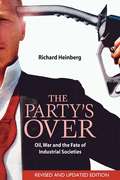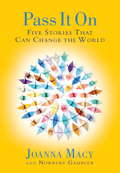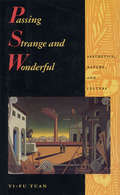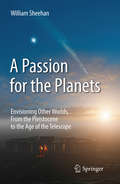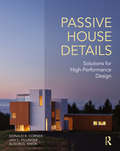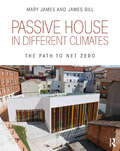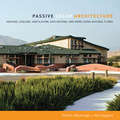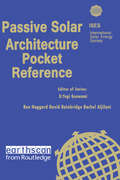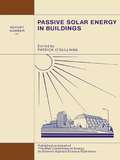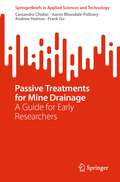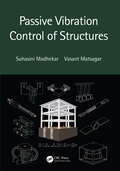- Table View
- List View
Partition Functions and Automorphic Forms (Moscow Lectures #5)
by Valery A. Gritsenko Vyacheslav P. SpiridonovThis book offers an introduction to the research in several recently discovered and actively developing mathematical and mathematical physics areas. It focuses on: 1) Feynman integrals and modular functions, 2) hyperbolic and Lorentzian Kac-Moody algebras, related automorphic forms and applications to quantum gravity, 3) superconformal indices and elliptic hypergeometric integrals, related instanton partition functions, 4) moonshine, its arithmetic aspects, Jacobi forms, elliptic genus, and string theory, and 5) theory and applications of the elliptic Painleve equation, and aspects of Painleve equations in quantum field theories. All the topics covered are related to various partition functions emerging in different supersymmetric and ordinary quantum field theories in curved space-times of different (d=2,3,…,6) dimensions. Presenting multidisciplinary methods (localization, Borcherds products, theory of special functions, Cremona maps, etc) for treating a range of partition functions, the book is intended for graduate students and young postdocs interested in the interaction between quantum field theory and mathematics related to automorphic forms, representation theory, number theory and geometry, and mirror symmetry.
Partnering with Nature: The Wild Path to Reconnecting with the Earth
by Catriona MacgregorPartnering with Nature is a simple book with a powerful message: our connections to the natural environment-- and ultimately, to ourselves--are crucial in today's fragmented world. As each successive generation moves farther away from nature, the growing disconnect is expressed through physical as well as mental stress, from depression and fatigue in adults to attention disorders and obesity in children. The way we relate to nature helps define our place within it, and by awakening this natural, yet dormant connection to the environment around us, we can move beyond solitary stewardship and into partnership.In Partnering with Nature, Catriona MacGregor weaves together scientific and historical wisdom, spiritual insights, and inspiring stories that illuminate the energies that link humans, animals, and the natural world. Through observation and conscious practice, we can open up to the power of nature to transform our lives, uplift our spirits, and even to direct our bodies to a healthier potential. For everyone who has a sense of something missing, who wishes to make a difference in their world, who yearns to reclaim their sense of wonder and awe, or who struggles with their health or emotional balance--nature speaks to all who will listen.
Partnerships and the Sustainable Development Goals (Sustainable Development Goals Series)
by Enda Murphy Aparajita Banerjee Patrick Paul WalshThis volume fills a significant gap in the scientific and policy literature on the Sustainable Development Goals (SDGs) and on SDG 17 which focuses on partnership as a means of implementation (MOI) for the SDGs. The collection offers a strong theoretical context, and outlines the nature of partnerships (e.g. alternative forms, multi-level forms, barriers to take-up) using the most recent UN database as well as through key case studies that highlight partnership successes and failures at local, national and global scales. The text covers a brief history and background of partnerships and the SDGs, an analysis of existing SDG partnership using UN data, a scalar analysis of case studies involving multi-stakeholder partnerships, and recommendations for successful partnership models and implementation strategies. The book will be relevant for a wide variety of readerships including academics in different policy fields and disciplines, policymakers, SDG advocates and practitioners, and NGOs active in the promotion of the SDGs and environmental issues. Provides a unique outline of partnership theory and its application to the SDGs Outlines the nature of partnerships, including their multi-level forms and barriers to take-up using UN data Analyzes key SDG partnerships case studies that highlight partnership success stories for practitioners
Partnerships for Empowerment: Participatory Research for Community-based Natural Resource Management
by Carl Wilmsen William Elmendorf Larry Fisher Jacquelyn Ross Brinda Sarathy Gail WellsParticipatory research has emerged as an approach to producing knowledge that is sufficiently grounded in local needs and realities to support community-based natural resource management (CBNRM), and it is often touted as crucial to the sustainable management of forests and other natural resources. This book analyses the current state of the art of participatory research in CBNRM. Its chapters and case studies examine recent experiences in collaborative forest management, harvesting impacts on forest shrubs, watershed restoration in Native American communities, civic environmentalism in an urban neighborhood and other topics. Although the main geographic focus of the book is the United States, the issues raised are synthesized and discussed in the context of recent critiques of participatory research and CBNRM worldwide. The book's purpose is to provide insights and lessons for academics and practitioners involved in CBNRM in many contexts. The issues it covers will be relevant to participatory research and CBNRM practitioners and students the world over.
Partnerships for Livable Cities
by Cor Van Montfort Ank MichelsIn this volume scholars from around the world discuss the innovative forms of collaboration between public and private actors that contribute to making our cities more liveable. It offers helpful insights into the practices of partnerships and the ways in which partnerships can contribute to a more liveable urban environment. The liveability of our cities is a topic of increasing relevance and urgency. The world’s cities are becoming congested and polluted, putting pressure on affordable housing and causing safety to become a major problem. Urban governments are unable to address these major challenges on their own, and thus they seek cooperation with other governments, companies, civil society organizations, and citizens. By focusing on examples such as greenery in the city, affordable housing, safety, neighbourhood revitalization, and ‘learning by doing’ in urban living labs, this book asks two key questions. How do partnerships between public and private actors contribute to the liveability of cities? Under what conditions are partnerships successful, and when do they fail to yield the desired results?
Partnerships for Protection: New Strategies for Planning and Management for Protected Areas
by Sue Stolton Nigel Dudley Biksham Gujja Bill Jackson Jean-Paul Jeanrenaud Gonzalo Oviedo Pedro Rosabal Adrian Phillips Sue WellsTaking into consideration the fact that many ecosystems are under-represented in protected areas of land and water and traditional management methods have often been ineffective, this volume describes how improvements can be made. Specifically, it explores ways of ensuring that all major ecosystems are safeguarded, and innovative approaches to conservation involving individuals, communities, companies and governments. The essence of the approach taken in the text is to build partnerships with those who have a stake in the care of land and water resources.
Partnerships For Reducing Landslide Risk: Assessment of the National Landslide Hazards Mitigation Strategy
by Committee on the Review of the National Landslide Hazards Mitigation StrategyLandslides occur in all geographic regions of the nation in response to a wide range of conditions and triggering processes that include storms, earthquakes, and human activities. Landslides in the United States result in an estimated average of 25 to 50 deaths annually and cost $1 to 3 billion per year. In addition to direct losses, landslides also cause significant environmental damage and societal disruption. This report reviews the U.S. Geological Survey’s (USGS) National Landslide Hazards Mitigation Strategy, which was created in response to a congressional directive for a national approach to reducing losses from landslides. Components of the strategy include basic research activities, improved public policy measures, and enhanced mitigation of landslides.The NRC report commends the USGS for creating a national approach based on partnerships with federal, state, local, and non-governmental entities, and finds that the plan components are the essential elements of a national strategy. The report recommends that the plan should promote the use of risk analysis techniques, and should play a vital role in evaluating methods, setting standards, and advancing procedures and guidelines for landslide hazard maps and assessments. The NRC panel suggests that substantially increased funding will be required to implement a national landslide mitigation program, and that as part of a 10-year program the funding mix should transition from research and guideline development to partnership-based implementation of loss reduction measures.
Party Polarization in America: The War Over Two Social Contracts
by Wood Soren Jordan B. DanThis book develops a general explanation for party polarization in America from both historical and contemporary perspectives. Prior polarization studies focused exclusively on the modern era, but this work traces party polarization from the constitutional convention of 1787 to the present. Using such a broad historical perspective shows that what was unusual in American history was the period of low polarization from the Great Depression through 1980, rather than the period of high polarization of the modern era. Polarization is the norm of the American system, not the exception, and is likely to persist in the future. More theoretically, party polarization in America has been due to class-based conflict and rent-seeking by the patrician and plebian classes in various historical eras, rather than conflict over cultural values. As in earlier historical eras, modern party polarization has largely been elite-driven, with party entrepreneurs cunningly and strategically using polarization to their advantage.
The Party's Over
by Richard HeinbergThe world is about to run out of cheap oil and change dramatically. Within the next few years, global production will peak. Thereafter, even if industrial societies begin to switch to alternative energy sources, they will have less net energy each year to do all the work essential to the survival of complex societies. We are entering a new era, as different from the industrial era as the latter was from medieval times. In The Party's Over, Richard Heinberg places this momentous transition in historical context, showing how industrialism arose from the harnessing of fossil fuels, how competition to control access to oil shaped the geopolitics of the twentieth century and how contention for dwindling energy resources in the twenty-first century will lead to resource wars in the Middle East, Central Asia and South America. He describes the likely impacts of oil depletion and all of the energy alternatives. Predicting chaos unless the United States--the world's foremost oil consumer--is willing to join with other countries to implement a global program of resource conservation and sharing, he also recommends a "managed collapse" that might make way for a slower-paced, low-energy, sustainable society in the future. More readable than other accounts of this issue, with fuller discussion of the context, social implications and recommendations for personal, community, national and global action, Heinberg's updated book is a riveting wake-up call for human-kind as the oil era winds down, and a critical tool for understanding and influencing current US foreign policy.
Paryatan Bhugol First Semester FYBA New NEP Syllabus - SPPU: पर्यटन भूगोल प्रथम सत्र एफ.वाय.बी.ए. नवीन एन.इ.पी. अभ्यासक्रम - सावित्रीबाई फुले पुणे यूनिवर्सिटी
by Prof. Dr. Dilip Dnyaneshwar Muluk Prof. Nitin Bajirao Borse Prof. Dr. Jyotiram Chandrakant More Prof. Dr. Sanjay Dagu Pagarपर्यटन भूगोल हे पुस्तक सावित्रीबाई फुले पुणे विद्यापीठाच्या नवीन राष्ट्रीय शैक्षणिक धोरण (NEP) 2020 अंतर्गत विकसित केले गेले आहे. "पर्यटन भूगोल" या पुस्तकात पर्यटनाच्या संकल्पना, घटक, प्रकार आणि नियोजनाच्या तांत्रिक बाबींचा सखोल अभ्यास केला आहे. पुस्तकामध्ये पर्यावरणीय, सामाजिक, सांस्कृतिक व आर्थिक दृष्टिकोनातून पर्यटनाच्या विविध पैलूंचा आढावा घेतला आहे. सत्र 1 मध्ये पर्यटन भूगोलाची व्याख्या, स्वरूप, पर्यटनाचे वर्गीकरण व आधुनिक प्रकार मांडले आहेत. सत्र 2 मध्ये सहल नियोजन, आवश्यक तंत्रज्ञान, पासपोर्ट-व्हिसा प्रक्रिया, आणि राष्ट्रीय-आंतरराष्ट्रीय सहल नियोजनाचा समावेश आहे. पुस्तक विद्यार्थ्यांसह, पर्यटन व्यवसायाशी संबंधित प्राध्यापक, संशोधक व पर्यटकांसाठी अत्यंत उपयुक्त आहे.
Paryavaran Aur Hum class 7 - JCERT: पर्यावरण और हम ७वीं कक्षा - जेसीईआरटी
by Jharkhand Shaikshik Anusandhan Evam Prashikshan Parishad Ranchi"पर्यावरण और हम" पुस्तक झारखंड शैक्षिक अनुसंधान एवं प्रशिक्षण परिषद द्वारा प्रकाशित की गई है। यह सातवीं कक्षा के भूगोल विषय पर आधारित है और छात्रों में पर्यावरण के प्रति जागरूकता बढ़ाने के उद्देश्य से लिखी गई है। पुस्तक में प्राकृतिक एवं मानव निर्मित पर्यावरण की जानकारी दी गई है, जिसमें स्थलमंडल, जलमंडल, वायुमंडल, जैवमंडल आदि विषयों का विस्तार से वर्णन किया गया है। प्राकृतिक पर्यावरण में भूमि, जल, वायु, पेड़-पौधे और जीव-जंतु शामिल होते हैं, जबकि मानव निर्मित पर्यावरण में इंसानों द्वारा बनाई गई वस्तुएँ जैसे सड़क, घर, और मशीनें शामिल हैं। पुस्तक में पर्यावरण प्रदूषण के विभिन्न प्रकार जैसे वायु, जल और भूमि प्रदूषण के कारण और उनके निवारण के उपाय भी बताए गए हैं। इसमें जलवायु परिवर्तन और उसके प्रभावों पर भी चर्चा की गई है। पुस्तक का एक महत्वपूर्ण हिस्सा यह बताता है कि कैसे हम छोटे-छोटे कदमों से पर्यावरण संरक्षण में योगदान दे सकते हैं। जलवायु परिवर्तन, ग्लोबल वार्मिंग, और प्राकृतिक संसाधनों के उपयोग के प्रति संवेदनशीलता विकसित करने के उद्देश्य से यह पुस्तक विद्यार्थियों के लिए बेहद उपयोगी है। छात्रों को पर्यावरण संरक्षण के प्रति जिम्मेदार और जागरूक नागरिक बनाने के लिए इसमें शिक्षकों के सहयोग और सहभागिता को भी महत्वपूर्ण बताया गया है।
Pass it On: Five Stories That Can Change the World
by Joanna Macy Norbert GahblerEco-philosopher and best-selling author Joanna Macy, Ph.D., shares five stories from her more than thirty years of studying and practicing Buddhism and deep ecology. Gathered on her travels to India, Russia, Australia, and Tibet, these stories give testament to Joanna Macy's belief that either humankind awakens to a new and deeper understanding of our interconnectedness with our planet and all its myriad forms of life or risks loosing it. To bring about such a transformation of consciousness each and every one of us counts. Five Stories that Can Change the World tells of encounters with individuals who share very personal stories of sudden awakening, unexpected awareness, and the co-mingling of joy and pain. Each story is imbued with the specific cultural flavor of the places where the stories originate, but all share that each individual counts in the global need for change and awakening.Pas It On provides an introduction to Joanna Macy's work of "deep ecology" and "the great turning" and the deep interconnected nature of all beings.Introduction by Norbert Gahbler.
Pass it On
by Joanna Macy Norbert GahblerEco-philosopher and best-selling author Joanna Macy shares five stories from her more than 30 years of studying and practicing Buddhism and deep ecology. Gathered on her travels to India, Russia, Australia, and Tibet, these stories testify to Joanna Macy's belief that either humankind awakens to a new and deeper understanding of our interconnectedness with its planet or risks loosing it. Pass it On tells of encounters with individuals who share very personal stories of sudden awakening, unexpected awareness, and the co-mingling of joy and pain. Each story is imbued with the specific cultural flavor of the places where the stories originate, but all show how each individual counts in the global need for change and awakening.
Pass the Energy, Please!
by Barbara McKinneyNature's food chains are sometimes short (grass eaten by deer) and sometimes long (goldenrod eaten by caterpillar, eaten by spider, eaten by warbler, eaten by weasel, eaten by fox). Everyone is part of nature's fascinating circle of players.
Passing Strange and Wonderful: Aesthetics Nature And Culture
by Yi-Fu TuanIn this rich and rewarding work, Yi-Fu Tuan vividly demonstrates that feeling and beauty are essential components of life and society. The aesthetic is not merely one aspect of culture but its central core -- both its driving force and its ultimate goal.Beginning with the individual and his physical world, Tuan's exploration progresses from the simple to the complex. His initial evaluation of the building blocks of aesthetic experience (sight, hearing, smell, taste, touch) develops gradually into a wide-ranging examination of the most elaborate of human constructs, including art, architecture, literature, philosophy, music, and more.
A Passion for the Planets: Envisioning Other Worlds, From the Pleistocene to the Age of the Telescope
by William SheehanAstronomy is by far the most popular of the physical sciences, enticing enough to become a major cultural preoccupation for many, and for some an enthralling scientific activity which veritably rules their lives. What is the nature of that seemingly unstoppable attraction? In this lively and compelling account, William Sheehan - professional psychiatrist, noted historian of astronomy, and incurable observer - explores the nature of that allure through the story of man's visual exploration of the planets. In this volume, the first of a trilogy, Sheehan starts with observational astronomy's profound and lasting effect on his own life, setting the points of embarkation for the journey to come. He travels across the historical landscape seeking the earliest origins of man's compulsion to observe the planets among the hunter gatherers of the upper palaeolithic, and traces the evolving story from the planetary records of the earliest cities, to Pharonic Egypt through to Hellenistic Greek astronomy culminating in Ptolemy. The necessity to observe played its part in the perceptual changes wrought by the Copernican revolution, as well as the observational advances achieved by such extraordinary characters as Tycho with his sharpest of eyes, and his luxurious practice of total astronomy. The two epochal advances published in 1609, both born through planetary observation, namely Kepler's discovery of the true nature of the orbit of Mars and Harriot and Galileo's observations of the Moon, have a pivotal place in this account. Sheehan weaves a rich tapestry of social and technological settings, patronage and personalities, equipment and skills, cosmologies and goals, motives and compulsions to try to explain why we have observed, and continue to observe, the planets. The compelling text of A Passion for the Planets is enhanced by the specially commissioned planetary artwork of Julian Baum, himself son of a noted planetary observer and historian of planetary observers, and Randall Rosenfeld. A Passion for the Planets will be of interest to all amateur astronomers; active planetary observers; armchair astronomers; those interested in the history of astronomy; the cultural history of science; and astronomical art.
Passive Energy Strategies for Mediterranean Residential Buildings
by Aurora Monge-Barrio Ana Sánchez-Ostiz GutiérrezThis book presents an approach to energy-efficient building design, which takes into account the most important challenges in climate change mitigation and adaptation in Southern Europe. It outlines a specific approach related to residential buildings and their intergenerational and vulnerable occupants, such as ageing population and users in fuel poverty. It also focuses on the use of passive energy measures throughout the year, and on pursuing a realistic and affordable approach to the efficient rehabilitation of resilient residential buildings.In addition, the book presents case studies that include surveys, monitoring, and simulation of residential buildings in Spain and other Southern European representative locations, in order to go further on the study of this challenging topic.
Passive House Details: Solutions for High-Performance Design
by Donald B. Corner Jan C. Fillinger Alison G. KwokPassive House Details introduces the concepts, principles, and design processes of building ultralow-energy buildings. The objective of this book is to provide design goals, research, analysis, systems, details, and inspiring images of some of the most energy-efficient, carbon-neutral, healthy, and satisfying buildings currently built in the region. Other topics included: heat transfer, moisture management, performance targets, and climatic zones. Illustrated with more than 375 color images, the book is a visual catalog of construction details, materials, and systems drawn from projects contributed from forty firms. Fourteen in-depth case studies demonstrate the most energy-efficient systems for foundations, walls, floors, roofs, windows, doors, and more.
Passive House in Different Climates: The Path to Net Zero
by Mary James James BillPassive House in Different Climates introduces the seven Passive House principles, to help you create super-insulated, airtight buildings that require minimal energy use to heat, cool, dehumidify, and ventilate, with superior indoor air quality and year-round comfort. Seventeen case studies in four climate zones---marine, cold and very cold, mixed-dry and hot-dry, and mixed-humid and hot-humid---and in ten countries, show you how to achieve net-zero energy regardless of where you’re building or what type of building is required. Includes more than 150 color illustrations.
Passive Solar Architecture
by David A. Bainbridge Ken HaggardThis pocket reference book provides a wealth of practical information at your fingertips, whenever you need it. Rich in background detail, at-a-glance tables and diagrams, equations, and more, the Passive Solar Architecture Pocket Referenceis a handy resource for architects, engineers and students. Coverage includes: Definitions Load determinants and Responses (including world wide biomes and climates, building metabolism and response, thermal sources and sinks, passive building responses to sources and sinks, tuning the building to the environment, optimizing insulation & thermal mass for comfort) Contextual Aspects (including microclimate and siting, temperatures, humidity, wind, radiation and comfort parameters) Passive Components (including building envelope, passive solar terminology, orientation, apertures and glazing, thermal storage, thermal control and materials Design Tools (including sun path diagrams, sun peg diagrams, air flow relationships, thermal modelling and life cycle design) Specific Functions (including passive heating, passive cooling and ventilation, natural lighting, passive water heating, resource collection and Integrated design)
Passive Solar Architecture Pocket Reference (Energy Pocket Reference)
by Ken Haggard David A. Bainbridge Rachel AljilaniOur pocket reference books provide a wealth of practical information at your fingertips, whenever you need it. Rich in background detail, at-a-glance tables and diagrams, equations, and more, the Passive Solar Architecture Pocket Reference is a handy resource for architects, engineers and students. Coverage includes: definitions load determinants and Responses (including world wide biomes and climates, building metabolism and response, thermal sources and sinks, passive building responses to sources and sinks, tuning the building to the environment, optimizing insulation & thermal mass for comfort) contextual aspects (including microclimate and siting, temperatures, humidity, wind, radiation and comfort parameters passive components (including building envelope, passive solar terminology, orientation, apertures and glazing, thermal storage, thermal control and materials design tools (including sun path diagrams, sun peg diagrams, air flow relationships, thermal modelling and life cycle design specific functions (including passive heating, passive cooling and ventilation, natural lighting, passive water heating, resource collection and integrated design).
Passive Solar Energy in Buildings: Watt Committee: report number 17
by Patrick O´SullivanThis report indicates that the benefits that accrue to a building and its occupants from a consideration of solar radiation are greatest when the 'passive solar component' is seen in perspective, as a natural part of an integrated approach to climatically interactive low-energy building design.
The Passive Solar House
by James KachadorianRevised and Expanded Edition-Includes CD-ROM with Custom Design SoftwareFor the past ten years The Passive Solar House has offered proven techniques for building homes that heat and cool themselves, using readily available materials and methods familiar to all building contractors and many do-it-yourself homeowners. True to this innovative, straightforward approach, the new edition of this best-selling guide includes CSOL passive solar design software, making it easier than ever to heat your home with the power of the sun. Since The Passive Solar House was first published, passive solar construction expert James Kachadorian has perfected user-friendly, Windows-compatible software to supplement the design process explained in the book by allowing homeowners/designers to enter the specifications of their design and see how changing a variable will affect its energy efficiency. This is the building book for a world of climbing energy costs. Applicable to diverse regions, climates, budgets, and styles of architecture, Kachadorian's techniques translate the essentials of timeless solar design into practical wisdom for today's solar builders. Profiles of successful passive solar design, construction, and retrofit projects from readers of the first edition provide inspiration to first-time homebuilders and renovators alike.
Passive Treatments for Mine Drainage: A Guide for Early Researchers (SpringerBriefs in Applied Sciences and Technology)
by Cassandra Chidiac Aaron Bleasdale-Pollowy Andrew Holmes Frank GuThis book allows readers to grasp both the fundamentals and the latest technological advances in the field of mine drainage, which is increasingly crucial both environmentally and economically. Its extensive coverage of current and promising passive treatment technologies, combined with numerous practical guides, makes it an indispensable tool for early researchers seeking promising trends and identifying gaps.The book systematically explores recent literature on passive treatment research, classifying them as preventative, in-situ, and ex-situ solutions. It covers relevant passive treatments such as permeable reactive barriers, constructed wetlands, gravel bed reactors, saturated rock fills, and passivation techniques, among other common source control tactics. Each technology is discussed in terms of principal mechanisms, state-of-the-art technological advances, advantages and disadvantages, and suitability for a given mine drainage chemistry and flow regime. The book provides a comprehensive view of the entire field, offering researchers and policymakers a reference guide, research ideas, understanding, and practical applications for each technology.Furthermore, the contains an overview of recent trends in material selection for passive treatment applications, primarily through the use of industrial waste and by-products, which incorporate more sustainable practices in mine drainage remediation. Uniquely, the manuscript includes a flowchart based on water chemistry and flow rates to guide readers to ideal treatment options, along with written analysis to further support the readers’ decision-making. Overall, this equips early researchers in the field with knowledge of fundamentals and promising research routes when dealing with different mine drainage complexities while also providing them with promising research avenues that can advance the field further.
Passive Vibration Control of Structures
by Suhasini Madhekar Vasant MatsagarResearch in vibration response control deals not only with prevention of catastrophic failures of structures during natural or accidental/manmade hazards but also ensures the comfort of occupants through serviceability. Therefore, the focus of this book is on the theory of dynamic response control of structures by using different kinds of passive vibration control devices. The strategies used for controlling displacement, velocity, and acceleration response of structures such as buildings, bridges, and liquid storage tanks under the action of dynamic loads emanating from earthquake, wind, wave, and so forth are detailed. The book: Explains fundamentals of vibration response control devices and their practical applications in response mitigation of structures exposed to earthquake, wind, and wave loading Offers a comprehensive overview of each passive damper, its functioning, and mathematical modeling in a dynamical system Covers practical aspects of employing the passive control devices to some of the benchmark problems that are developed from existing buildings and bridges in different countries worldwide Includes MATLAB® codes for determining the dynamic response of single degree of freedom (SDOF) and multi-degree of freedom (MDOF) systems along with computational models of the passive control devices This book is aimed at senior undergraduate students, graduate students, and researchers in civil, earthquake, aerospace, automotive, mechanical engineering, engineering dynamics, and vibration control, including structural engineers, architects, designers, manufacturers, and other professionals.
